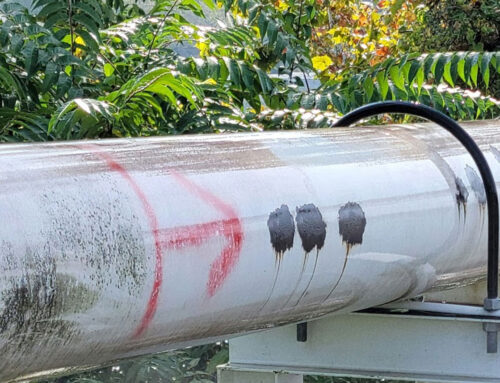The Different Standards of Sandblasting: A Helpful Glossary for Industrial Businesses
Every industrial painting job begins with surface assessment and surface preparation. The more severe the damage is to the surface, the more aggressive the treatment industrial painters will use. To help clarify the range of sandblasting standards, we built a glossary for our current and future industrial clients. Read on to learn more.
Solvent Cleaning
Solvent Cleaning (SSPC-SP1) removes dust, oil, dirt, and soluble materials from a steel surface. The standard for solvent cleaning allows for it to be applied in a variety of ways, including steaming, spraying, immersing, and scrubbing. The standard does require dust to be removed after cleaning by vacuum or dry air.
Hand Tool Cleaning
Hand Tool Cleaning (SSPC-SP2) treats surfaces with loose debris, such as rust and paint. Industrial painters use non-powered hand tools to scrape and clear off the debris typically after solvent cleaning. Dust removal is necessary after any hand tool cleaning.
Power Tool Cleaning
Power Tool Cleaning (SSPC-SP3) uses rotary brushing, power brushing, and impact brushing to remove corrosion products and weld slag from surfaces. It’s preceded by solvent cleaning and followed by dust removal, just like the hand tool cleaning standard. Power tool cleaning also has a preventative measure to smooth sharp cuts and burrs from surfaces.
White Metal Blasting
A White Metal Blast Clean (SSPC-SP5) uses a combination of dry abrasive and wet blasting to remove oxidation from a steel surface. After a white metal blast, industrial painters must remove dust and oil from the surface and inspect it before painting or coating.
Brush Off Blast Cleaning
A Brush Off Blast Clean (SSPC-SP7) removes all loose debris and oxidation from a surface. Then, the blasting will roughen the surface without removing all previously applied coating. Evidence of some rust also may remain after a Brush Off Blast Clean.
Near-White Metal Blast Cleaning
A Near-White Metal Blast Clean (SSPC-SP10) finds a middle ground between the very aggressive White Metal Blast Cleaning and more gentle types of commercial blast cleaning. It removes all surface contaminants; the standard requires less than 5 percent of the surface to have any kind of staining.
Power Tool Cleaning to Bare Metal
Gentler than many blast cleans, Power Tool Cleaning to Bare Metal (SSPC-SP11) requires surface contaminants to be removed first. Then, industrial painters use grinding tools to create a surface suitable for coating.
Waterjetting Prior to Recoating
Waterjetting (SSPC-SP12) uses extremely high pressure to remove debris and contaminants from a surface. Unlike many of the other listed standards, waterjetting does not change how rough a surface is but meticulously cleans it prior to new coating application.
Brush-off Blast Cleaning of Galvanized Steel, Stainless Steel, and Non-Ferrous Metals
Brush-off blast cleaning (SSPC-SP 16) is used to remove surface contaminants and corrosion from galvanized steel before industrial paints apply a powder coat. It creates a rougher surface.
Does Your Industrial Business Need Sandblasting Services? Reach Out to Eagle Eye Services for an Estimate Today.
Sandblasting is a necessary step in preparing a surface before we perform certain kinds of interior and exterior industrial painting jobs. At Eagle Eye Services, our goal is to keep sandblasting within your budget and within your project’s timeframe. We encourage you to reach out to our team of industrial painters for a free estimate. To contact us today, call Eagle Eye Services at 724-754-1122.
Ready to Get Started?
Have questions about your project or need a quote? We’ve got someone ready to help you.



